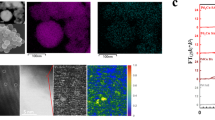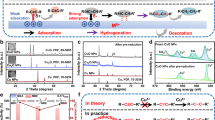Abstract
The renaissance of catalytic metal hydride hydrogen atom transfer (MHAT) offers advanced tools for radical chemistry on simple olefins. While 3d transition metals like cobalt, iron and manganese have been extensively studied in catalytic MHAT, the potential of copper remains unexplored. This is due to the polar reactivity exhibited by classical nucleophilic Cu(I)–H. Here we report copper-catalysed MHAT-like oxidative hydrofunctionalization reactions. In contrast to conventional Cu(I)–H chemistry, the putative Cu-MHAT process produces alkyl radicals with high chemoselectivity and regioselectivity, which are subsequently captured by Cu(II) species to undergo coupling reactions with a broad scope of oxygen-, nitrogen-, halogen- and carbon-based nucleophiles. Preliminary results suggest viable extension to asymmetric catalysis and radical polymerization. This work offers a complementary oxidative MHAT platform.

This is a preview of subscription content, access via your institution
Access options
Access Nature and 54 other Nature Portfolio journals
Get Nature+, our best-value online-access subscription
27,99 € / 30 days
cancel any time
Subscribe to this journal
Receive 12 digital issues and online access to articles
118,99 € per year
only 9,92 € per issue
Buy this article
- Purchase on SpringerLink
- Instant access to full article PDF
Prices may be subject to local taxes which are calculated during checkout





Similar content being viewed by others
Data availability
The data that support the findings in this study are available within the Article and its Supplementary Information or available from the corresponding author upon request. Crystallographic data for the structure reported in this Article have been deposited at the Cambridge Crystallographic Data Centre under deposition number CCDC 2280327 (46). Copies of the data can be obtained free of charge via https://www.ccdc.cam.ac.uk/structures/.
References
Simonneau, A. & Oestreich, M. Fascinating hydrogen atom transfer chemistry of alkenes inspired by problems in total synthesis. Angew. Chem. Int. Ed. 54, 3556–3558 (2015).
Shevick, S. L. et al. Catalytic hydrogen atom transfer to alkenes: a roadmap for metal hydrides and radicals. Chem. Sci. 11, 12401–12422 (2020).
Crossley, S. W., Obradors, C., Martinez, R. M. & Shenvi, R. A. Mn-, Fe-, and Co-catalysed radical hydrofunctionalizations of olefins. Chem. Rev. 116, 8912–9000 (2016).
Isayama, S. & Mukaiyama, T. A new method for preparation of alcohols from olefins with molecular oxygen and phenylsilane by the use of bis(acetylacetonato)cobalt(II). Chem. Lett. 18, 1071–1074 (1989).
Eisenberg, D. C. & Norton, J. R. Hydrogen-atom transfer reactions of transition-metal hydrides. Isr. J. Chem. 31, 55–66 (1991).
Waser, J. & Carreira, E. M. Convenient synthesis of alkylhydrazides by the cobalt-catalyzed hydrohydrazination reaction of olefins and azodicarboxylates. J. Am. Chem. Soc. 126, 5676–5677 (2004).
Waser, J. & Carreira, E. M. Catalytic hydrohydrazination of a wide range of alkenes with a simple Mn complex. Angew. Chem. Int. Ed. 43, 4099–4102 (2004).
Li, G., Han, A., Pulling, M. E., Estes, D. P. & Norton, J. R. Evidence for formation of a Co–H bond from (H2O)2Co(dmgBF2)2 under H2: application to radical cyclizations. J. Am. Chem. Soc. 134, 14662–14665 (2012).
Barker, T. J. & Boger, D. L. Fe(III)/NaBH4-mediated free radical hydrofluorination of unactivated alkenes. J. Am. Chem. Soc. 134, 13588–13591 (2012).
Shigehisa, H., Aoki, T., Yamaguchi, S., Shimizu, N. & Hiroya, K. Hydroalkoxylation of unactivated olefins with carbon radicals and carbocation species as key intermediates. J. Am. Chem. Soc. 135, 10306–10309 (2013).
Crossley, S. W., Barabe, F. & Shenvi, R. A. Simple, chemoselective, catalytic olefin isomerization. J. Am. Chem. Soc. 136, 16788–16791 (2014).
Gui, J. et al. Practical olefin hydroamination with nitroarenes. Science 348, 886–891 (2015).
Touney, E. E., Foy, N. J. & Pronin, S. V. Catalytic radical–polar crossover reactions of allylic alcohols. J. Am. Chem. Soc. 140, 16982–16987 (2018).
Song, L. et al. Dual electrocatalysis enables enantioselective hydrocyanation of conjugated alkenes. Nat. Chem. 12, 747–754 (2020).
Qin, T. et al. Cobalt-catalyzed radical hydroamination of alkenes with N-fluorobenzenesulfonimides. Angew. Chem. Int. Ed. 60, 25949–25957 (2021).
Kamei, Y. et al. Silane- and peroxide-free hydrogen atom transfer hydrogenation using ascorbic acid and cobalt-photoredox dual catalysis. Nat. Commun. 12, 966 (2021).
Nakagawa, M., Matsuki, Y., Nagao, K. & Ohmiya, H. A triple photoredox/cobalt/Brønsted acid catalysis enabling Markovnikov hydroalkoxylation of unactivated alkenes. J. Am. Chem. Soc. 144, 7953–7959 (2022).
Bergamaschi, E., Mayerhofer, V. J. & Teskey, C. J. Light-driven cobalt hydride catalyzed hydroarylation of styrenes. ACS Catal. 12, 14806–14811 (2022).
Serviano, J. M. I., Phipps, E. J. T. & Holland, P. L. Intermolecular hydroalkoxylation and hydrocarboxylation of 2-azadienes with high efficiency. J. Org. Chem. 88, 3277–3281 (2023).
Jordan, A. J., Lalic, G. & Sadighi, J. P. Coinage metal hydrides: synthesis, characterization, and reactivity. Chem. Rev. 116, 8318–8372 (2016).
Liu, R. Y. & Buchwald, S. L. CuH-catalyzed olefin functionalization: from hydroamination to carbonyl addition. Acc. Chem. Res. 53, 1229–1243 (2020).
Zhu, S. L., Niljianskul, N. & Buchwald, S. L. Enantio- and regioselective CuH-catalyzed hydroamination of alkenes. J. Am. Chem. Soc. 135, 15746–15749 (2013).
Miki, Y., Hirano, K., Satoh, T. & Miura, M. Copper-catalyzed intermolecular regioselective hydroamination of styrenes with polymethylhydrosiloxane and hydroxylamines. Angew. Chem. Int. Ed. 52, 10830–10834 (2013).
Zhu, S. L. & Buchwald, S. L. Enantioselective CuH-catalyzed anti-Markovnikov hydroamination of 1,1-disubstituted alkenes. J. Am. Chem. Soc. 136, 15913–15916 (2014).
Shi, S. L., Wong, Z. L. & Buchwald, S. L. Copper-catalysed enantioselective stereodivergent synthesis of amino alcohols. Nature 532, 353–356 (2016).
Shi, S. L. & Buchwald, S. L. Copper-catalysed selective hydroamination reactions of alkynes. Nat. Chem. 7, 38–44 (2015).
Wang, Y.-M., Bruno, N. C., Placeres, Á. L., Zhu, S. & Buchwald, S. L. Enantioselective synthesis of carbo- and heterocycles through a CuH-catalyzed hydroalkylation approach. J. Am. Chem. Soc. 137, 10524–10527 (2015).
Wahidur Rahaman, S. M., Matyjaszewski, K. & Poli, R. Cobalt(iii) and copper(ii) hydrides at the crossroad of catalysed chain transfer and catalysed radical termination: a DFT study. Polym. Chem. 7, 1079–1087 (2016).
Zerk, T. J., Gahan, L. R., Krenske, E. H. & Bernhardt, P. V. The fate of copper catalysts in atom transfer radical chemistry. Polym. Chem. 10, 1460–1470 (2019).
Mulac, W. A. & Meyerstein, D. Properties of copper(II) hydride formed in the reaction of aquacopper(I) ions with hydrogen atoms. A pulse radiolytic study. Inorg. Chem. 21, 1782–1784 (1982).
Eberhart, M. S. et al. Electron transfer from hexameric copper hydrides. J. Am. Chem. Soc. 135, 17262–17265 (2013).
Zhang, S. et al. A dinitrogen dicopper(I) complex via a mixed-valence dicopper hydride. Angew. Chem. Int. Ed. 55, 9927–9931 (2016).
Yang, W. et al. Enantioselective hydroxylation of dihydrosilanes to Si-chiral silanols catalyzed by in situ generated copper(II) species. Angew. Chem. Int. Ed. 61, e202205743 (2022).
Ryu, I., Kusumoto, N., Ogawa, A., Kambe, N. & Sonoda, N. Copper(II)-mediated stereoselective reduction of acetylenic sulfones by hydrosilanes. Organometallics 8, 2279–2281 (1989).
Norwine, E. E., Kiernicki, J. J., Zeller, M. & Szymczak, N. K. Distinct reactivity modes of a copper hydride enabled by an intramolecular Lewis acid. J. Am. Chem. Soc. 144, 15038–15046 (2022).
Van Hoveln, R. et al. Mechanistic studies of copper(I)-catalyzed 1,3-halogen migration. J. Am. Chem. Soc. 137, 5346–5354 (2015).
Golden, D. L. et al. Benzylic C–H esterification with limiting C–H substrate enabled by photochemical redox buffering of the Cu catalyst. J. Am. Chem. Soc. 145, 9434–9440 (2023).
Zhu, R. & Buchwald, S. L. Copper-catalyzed oxytrifluoromethylation of unactivated alkenes. J. Am. Chem. Soc. 134, 12462–12465 (2012).
Zhou, X.-L. et al. Cobalt-catalyzed intermolecular hydrofunctionalization of alkenes: evidence for a bimetallic pathway. J. Am. Chem. Soc. 141, 7250–7255 (2019).
Sun, H.-L., Yang, F., Ye, W.-T., Wang, J.-J. & Zhu, R. Dual cobalt and photoredox catalysis enabled intermolecular oxidative hydrofunctionalization. ACS Catal. 10, 4983–4989 (2020).
Orr, R. K. et al. A modular synthesis of 2-alkyl- and 2-arylchromans via a three-step sequence. Synthesis 49, 657–666 (2017).
Silvestri, R. et al. Imidazole analogues of fluoxetine, a novel class of anti-Candida agents. J. Med. Chem. 47, 3924–3926 (2004).
Deutsch, C. & Krause, N. CuH-catalyzed reactions. Chem. Rev. 108, 2916–2927 (2008).
Lipshutz, B. H. Rediscovering organocopper chemistry through copper hydride. It’s all about the ligand. Synlett 2009, 509–524 (2009).
Guo, S., Zhu, J. & Buchwald, S. L. Enantioselective synthesis of β-amino acid derivatives enabled by ligand-controlled reversal of hydrocupration regiochemistry. Angew. Chem. Int. Ed. 59, 20841–20845 (2020).
Zhu, S. L., Niljianskul, N. & Buchwald, S. L. A direct approach to amines with remote stereocentres by enantioselective CuH-catalysed reductive relay hydroamination. Nat. Chem. 8, 144–150 (2016).
Grigg, R. D., Van Hoveln, R. & Schomaker, J. M. Copper-catalyzed recycling of halogen activating groups via 1,3-halogen migration. J. Am. Chem. Soc. 134, 16131–16134 (2012).
Wang, Q., Jia, J.-F., Guo, C.-H. & Wu, H.-S. Mechanistic investigation of Cu(I)-mediated three-component domino reaction of asymmetrical alkynes with carbon dioxide: theoretical rationale for the regioselectivity. J. Organomet. Chem. 748, 84–88 (2013).
Deng, X., Dang, Y., Wang, Z.-X. & Wang, X. How does an earth-abundant copper-based catalyst achieve anti-Markovnikov hydrobromination of alkynes? A DFT mechanistic study. Organometallics 35, 1923–1930 (2016).
Kim, D., Rahaman, S. M. W., Mercado, B. Q., Poli, R. & Holland, P. L. Roles of iron complexes in catalytic radical alkene cross-coupling: a computational and mechanistic study. J. Am. Chem. Soc. 141, 7473–7485 (2019).
Zhang, W. et al. Enantioselective cyanation of benzylic C–H bonds via copper-catalyzed radical relay. Science 353, 1014–1018 (2016).
Chen, J.-J. et al. Enantioconvergent Cu-catalysed N-alkylation of aliphatic amines. Nature 618, 294–300 (2023).
Chen, C. & Fu, G. C. Copper-catalysed enantioconvergent alkylation of oxygen nucleophiles. Nature 618, 301–307 (2023).
Fu, N. et al. New bisoxazoline ligands enable enantioselective electrocatalytic cyanofunctionalization of vinylarenes. J. Am. Chem. Soc. 141, 14480–14485 (2019).
Zhu, R. & Buchwald, S. L. Enantioselective functionalization of radical intermediates in redox catalysis: copper-catalyzed asymmetric oxytrifluoromethylation of alkenes. Angew. Chem. Int. Ed. 52, 12655–12658 (2013).
Dadashi-Silab, S. & Stache, E. E. A hydrometalation initiation mechanism via a discrete cobalt-hydride for a rapid and controlled radical polymerization. J. Am. Chem. Soc. 144, 13311–13318 (2022).
Acknowledgements
Financial support was provided by the Natural Science Foundation of China (22222101, 22350006 and 22171012), Beijing Natural Science Foundation (2242006) and Beijing National Laboratory of Molecular Sciences (BNLMS). Computation was supported by the high-performance computing platform of Peking University (PKU). We thank X. Zhang (PKU) and H. Fu (PKU) for assistance with NMR spectroscopy and Y. Qiu (PKU) for assistance with X-ray crystallography. H.H. and J.W. acknowledge the PKU President’s Fellowship for Undergraduate Research.
Author information
Authors and Affiliations
Contributions
R.Z. proposed the transformation. J.-J.W., H.H., H.-L.S., F.Y. and J.W. conducted the experimental investigation. R.Z. and J.-J.W. wrote the manuscript. R.Z. directed the research.
Corresponding author
Ethics declarations
Competing interests
The authors declare no competing interests.
Peer review
Peer review information
Nature Catalysis thanks Shuanglin Qu and the other, anonymous, reviewer(s) for their contribution to the peer review of this work.
Additional information
Publisher’s note Springer Nature remains neutral with regard to jurisdictional claims in published maps and institutional affiliations.
Supplementary information
Supplementary Information
Supplementary Methods and references.
Supplementary Data 1
The .cif file for compound 46.
Supplementary Data 2
The .hkl file for compound 46.
Supplementary Data 3
The checkCIF file for compound 46.
Rights and permissions
Springer Nature or its licensor (e.g. a society or other partner) holds exclusive rights to this article under a publishing agreement with the author(s) or other rightsholder(s); author self-archiving of the accepted manuscript version of this article is solely governed by the terms of such publishing agreement and applicable law.
About this article
Cite this article
Wang, JJ., Huang, H., Sun, HL. et al. Mimicking hydrogen-atom-transfer-like reactivity in copper-catalysed olefin hydrofunctionalization. Nat Catal 7, 838–846 (2024). https://doi.org/10.1038/s41929-024-01182-9
Received:
Accepted:
Published:
Issue Date:
DOI: https://doi.org/10.1038/s41929-024-01182-9



